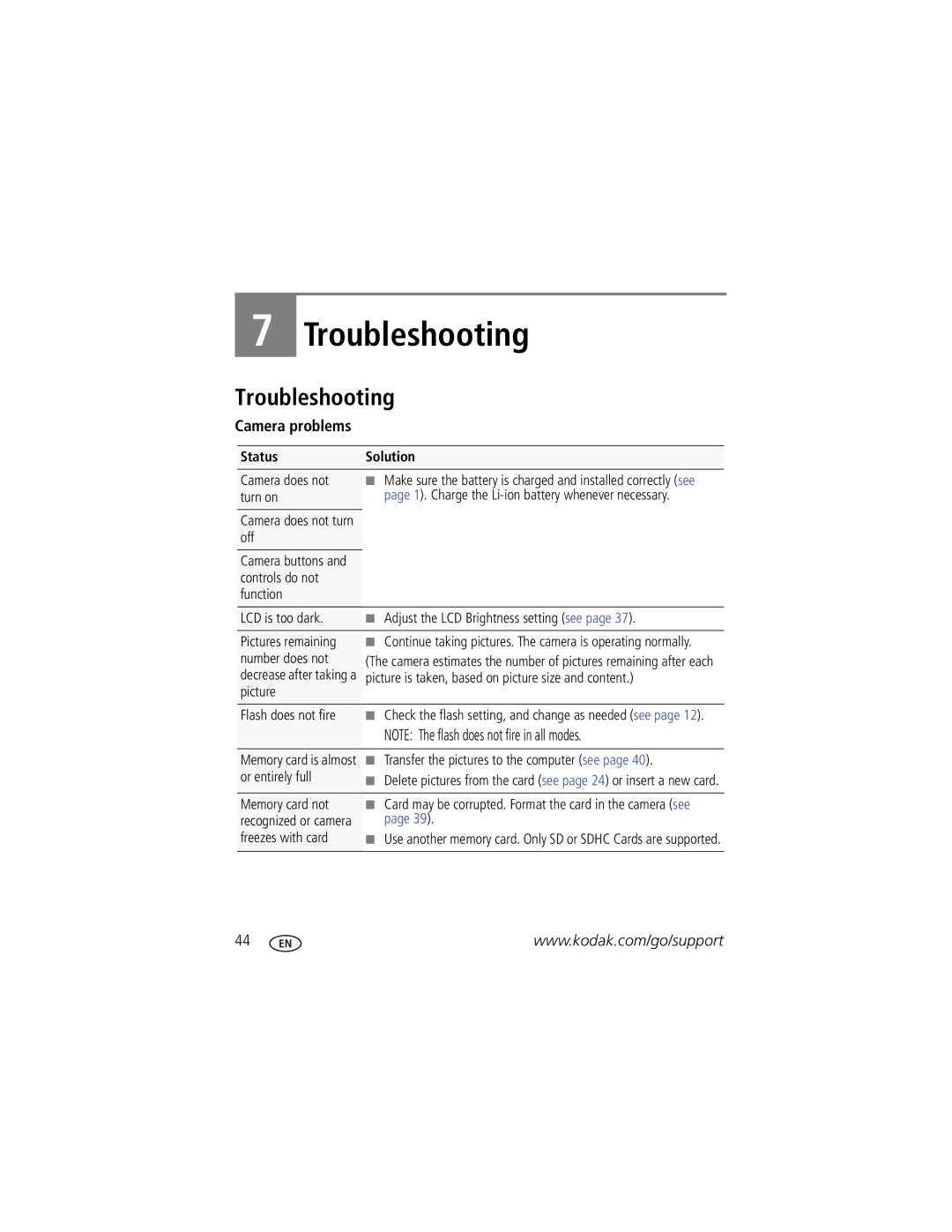Kodak Easyshare
For help with your camera
Eastman Kodak Company Rochester, New York
Front view
Delete button Menu button Info button
SD/SDHC Card slot Battery compartment Tripod socket
Back view
Zoom button USB port
Table of contents
Table of contents
Attaching the strap Loading the KLIC-7006 battery
Purchase extra batteries for your event Charge the battery
You can charge the Li-ion battery whenever necessary
Charging the battery
Using the in-camera battery charger
An external battery charger
Using the external battery charger
Charge via your computer’s USB port
Turning on the camera
Setting the language and date/time
Press the Power button
To change OK to accept
Storing pictures on an optional SD or Sdhc Card
Turn on the camera
Press the Shutter button halfway
Using the framing marks
Taking pictures
Take the picture
To review and work with videos, see
Taking a video
Reviewing the picture/video just taken
To review pictures/videos anytime, see
Using the camera mirror to take self-portraits
Understanding the picture-taking icons
Adjusting LCD brightness
Know when your battery needs charging
Using the optical zoom
Using digital zoom
Flash button
Using the flash
When the light is behind the subject
Off Never Red-eye
Scene
Using different modes
Use this mode For Smart Capture
Video
Using Scene SCN modes
Camera is now in the scene mode that you chose
Shortcuts appear. To hide the shortcuts again, press
Using shortcuts
Press to choose a setting. Shortcuts
Press the Menu button
Using the self-timer
Using burst
Taking panoramic pictures
Take the first picture
Press to choose Done, then press OK
Sharing pictures/videos through social networks
Press to choose a social networking site, then press OK
Tip Do you send pictures to the same sites each time?
When finished, press to choose Done, then press OK
Manage email addresses and Kodak Pulse Digital Frames
Tip Are faces not always detected?
Tagging pictures
Tagging people
Tip You can have up to 20 active names
Using the keyboard
Need to update a name?
Press the Review button, then to find a picture to tag
Marking pictures/videos for emailing
Tagging with keywords
Review
Reviewing pictures/videos
Playing a video
Playback speed
Protecting pictures/videos from deletion
Using the undo delete picture feature
Deleting pictures/videos
Press the Menu button to exit the menu
Viewing pictures/videos as thumbnails multi-up
Viewing pictures/videos in different ways
Magnifying a picture
Camera shows the last picture/video that was taken
Smarter way to find and enjoy your pictures
People All Date
For more about shortcuts, see
Know when your battery needs charging
Understanding the review icons
Displaying pictures/videos on a television
Cropping pictures
Using the menu button in review
Review Edit Setup
Using Kodak Perfect Touch Technology
Rotating pictures
Trimming a video
Adding a date stamp
Editing videos
Date/time is added to the picture
Video Press the Menu Button, then
Making a picture from a video
Making a video action print
Edit tab
Selecting multiple pictures/videos
Press OK to select pictures/videos
Picture Timer
Using the menu button to change settings
Self-timer/Burst
Off
Long Time Exposure
Settings More information
Color Mode
Focus/Exposure Zone
Settings More information White Balance
Focus Mode
AF Control Still
Use Setup to customize other camera settings
Using the Setup menu
Video settings available when the camera is in a Video mode
Individual social networking sites
Camera Sounds Volume
Function Shutter Self-timer Error Power On Exit Video Out
Button is pressed Mail addresses all or none
Format
Other Application Apple IPHOTO, etc
Computer
About View camera information
Turn on the camera
Transferring pictures to your computer
Turn off the camera
Download Kodak Software later Get Software help
Direct printing with a Kodak All-in-One Printer
Connecting the camera to a Kodak All-in-One Printer
Printing pictures
Printing from a Kodak All-in-One Printer
Printing from an optional SD or Sdhc Card
Disconnecting the camera from a Kodak All-in-One Printer
Ordering prints online
Marking your pictures for print
Status
Troubleshooting
Camera problems
Computer/connectivity problems
Status Solution
Direct printing Pictbridge enabled printer problems
Picture quality problems
Getting help on the Web
Face detection-Yes Face recognition-Yes
Specifications
Digital zoom-5X continuous
Long time exposure-0.5-8 seconds
Image file format
Still Exif 2.21 Jpeg compression file organization DCF
Upgrading your software and firmware
Care and maintenance
Operating temperature-0-40C 32-104F
Tripod mount-1/4 inch
Storage capacities Important safety instructions
When removing the battery, allow it to cool it may be hot
Do not charge non-rechargeable batteries
Battery replacement, battery life
Extending battery life
Limitations
Limited warranty
Limited warranty coverage
Your rights
Regulatory compliance
FCC compliance and advisory
Outside the United States and Canada
Appendix
N137
Australian C-Tick
Vcci Class B ITE China RoHS
Russian GOST-R
Korean Li-ion Regulatory
Korean Class B ITE
Telephoto/zoom
Date setting, 5 date/time stamp, 31 deleting
Out
USB
LCD brightness, 10, 37 lens Cleaning lens, 50 loading
Framing marks Guidelines, battery
Web links High ISO Icons, modes, 13 installing
Edit videos
Pictures
Playing a video, 23 power Camera, 5 printing
Marking For email, 22 memory
Emailing marked
Self-timer, 16 setting
Quickview, using
Safety
Timer, shutter delay, 16 tips Battery guidelines
USB

